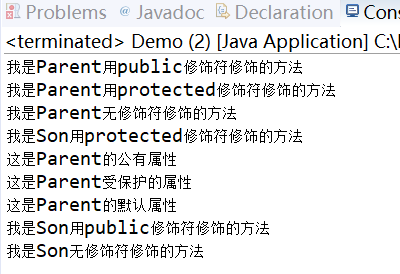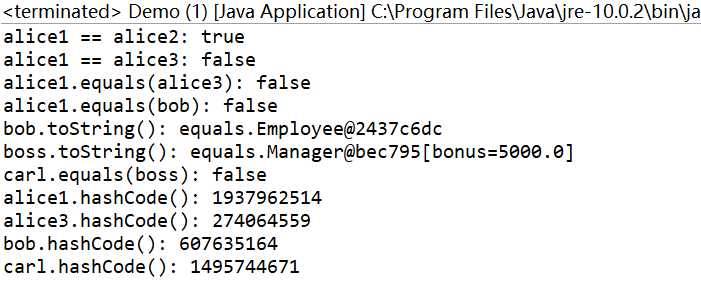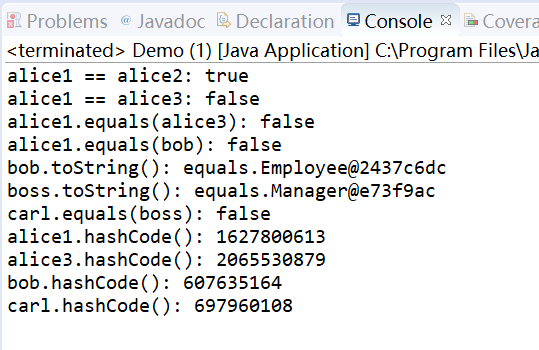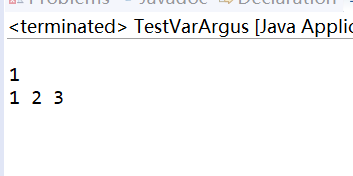201871010106-丁宣元 《面向对象程序设计(java)》第七周学习总结
正文开头:
|
项目 |
内容 |
|
这个作业属于哪个课程 |
https://home.cnblogs.com/u/nwnu-daizh/ |
|
这个作业的要求在哪里 |
https://www.cnblogs.com/nwnu-daizh/p/11654436.html |
|
作业学习目标 |
|
正文内容:
实验内容和步骤:
实验1:在“System.out.println(...);”语句处按注释要求设计代码替换...,观察代码录入中IDE提示,以验证四种权限修饰符的用法。
代码:
class Parent { private String p1 = "这是Parent的私有属性"; public String p2 = "这是Parent的公有属性"; protected String p3 = "这是Parent受保护的属性"; String p4 = "这是Parent的默认属性"; private void pMethod1() { System.out.println("我是Parent用private修饰符修饰的方法"); } public void pMethod2() { System.out.println("我是Parent用public修饰符修饰的方法"); } protected void pMethod3() { System.out.println("我是Parent用protected修饰符修饰的方法"); } void pMethod4() { System.out.println("我是Parent无修饰符修饰的方法"); } } class Son extends Parent{ private String s1 = "这是Son的私有属性"; public String s2 = "这是Son的公有属性"; protected String s3 = "这是Son受保护的属性"; String s4 = "这是Son的默认属性"; public void sMethod1() { System.out.println(p2);//p1无法打印,因为是私有属性 System.out.println(p3); System.out.println(p4);//分别尝试显示Parent类的p1、p2、p3、p4值 System.out.println("我是Son用public修饰符修饰的方法"); } private void sMethod2() { System.out.println("我是Son用private修饰符修饰的方法"); } protected void sMethod() { System.out.println("我是Son用protected修饰符修饰的方法"); } void sMethod4() { System.out.println("我是Son无修饰符修饰的方法"); } } public class Demo { public static void main(String[] args) { Parent parent=new Parent(); Son son=new Son(); parent.pMethod2(); parent.pMethod3(); parent.pMethod4();//分别尝试用parent调用Parent类的方法 son.sMethod();//用son调用Son类的方法 son.sMethod1(); son.sMethod4();//son.sMethod2()是private,只能在son类中使用 } }
结果:

注:protected和friendly都只能访问同一个包中的,但protected权限更大些,可访问不同包,但必须是子类继承父类。
实验2:导入第5章以下示例程序,测试并进行代码注释。
测试程序1:运行教材程序5-8、5-9、5-10,结合程序运行结果理解程序(教材174页-177页);
删除程序中Employee类、Manager类中的equals()、hasCode()、toString()方法,背录删除方法,在代码录入中理解类中重写Object父类方法的技术要点。
1.程序代码
5-8EqualsTest.java
package equals; /** * This program demonstrates the equals method. * @version 1.12 2012-01-26 * @author Cay Horstmann */ public class EqualsTest //主类 { public static void main(String[] args) { var alice1 = new Employee("Alice Adams", 75000, 1987, 12, 15); var alice2 = alice1; var alice3 = new Employee("Alice Adams", 75000, 1987, 12, 15); var bob = new Employee("Bob Brandson", 50000, 1989, 10, 1); System.out.println("alice1 == alice2: " + (alice1 == alice2)); System.out.println("alice1 == alice3: " + (alice1 == alice3)); System.out.println("alice1.equals(alice3): " + alice1.equals(alice3)); System.out.println("alice1.equals(bob): " + alice1.equals(bob)); System.out.println("bob.toString(): " + bob); var carl = new Manager("Carl Cracker", 80000, 1987, 12, 15); var boss = new Manager("Carl Cracker", 80000, 1987, 12, 15); boss.setBonus(5000); System.out.println("boss.toString(): " + boss); System.out.println("carl.equals(boss): " + carl.equals(boss)); System.out.println("alice1.hashCode(): " + alice1.hashCode()); System.out.println("alice3.hashCode(): " + alice3.hashCode()); System.out.println("bob.hashCode(): " + bob.hashCode()); System.out.println("carl.hashCode(): " + carl.hashCode()); } }
5-9Empolyee.java
package equals; import java.time.*; import java.util.Objects; public class Employee //用户自定义类 { private String name; //三个私有属性 private double salary; private LocalDate hireDay; public Employee(String name, double salary, int year, int month, int day) { this.name = name; this.salary = salary; hireDay = LocalDate.of(year, month, day); } public String getName() { return name; } public double getSalary() { return salary; } public LocalDate getHireDay() { return hireDay; } public void raiseSalary(double byPercent)//访问器 { double raise = salary * byPercent / 100; salary += raise; } public boolean equals(Object otherObject) { // a quick test to see if the objects are identical 测试几个类是否相同,若引用同一个,则相等 if (this == otherObject) return true; // must return false if the explicit parameter is null 若显式参数为空必须返回false if (otherObject == null) return false; // if the classes don't match, they can't be equal若几个类不匹配,则它们不相等 if (getClass() != otherObject.getClass()) return false; // now we know otherObject is a non-null Employee 已知otherObject是一个非空雇员 var other = (Employee) otherObject; // test whether the fields have identical values 检测是否具有相同的值 return Objects.equals(name, other.name) && salary == other.salary && Objects.equals(hireDay, other.hireDay); } public int hashCode()//重写hashcode方法,使得相等的两个对象获取的HashCode相等 { return Objects.hash(name, salary, hireDay); } public String toString() //其他类型数据转为字符串型的数据 { return getClass().getName() + "[name=" + name + ",salary=" + salary + ",hireDay=" + hireDay + "]"; } }
5-10Manager.java
package equals;
public class Manager extends Employee//子类Manager继承Employee
{
private double bonus;
public Manager(String name, double salary, int year, int month, int day)
{
super(name, salary, year, month, day);//子类调用超类中的属性
bonus = 0;
}
public double getSalary()//访问器
{
double baseSalary = super.getSalary();
return baseSalary + bonus;
}
public void setBonus(double bonus)
{
this.bonus = bonus;
}
public boolean equals(Object otherObject)
{
if (!super.equals(otherObject)) return false;
var other = (Manager) otherObject;
// super.equals checked that this and other belong to the same class 使用super.equals检查这个类和其他的是否属于同一个类
return bonus == other.bonus;
}
public int hashCode()
{
return java.util.Objects.hash(super.hashCode(), bonus);
}
public String toString()// toString()方法,可自动生成
{
return super.toString() + "[bonus=" + bonus + "]";
}
}
结果:

删除程序中Employee类、Manager类中的equals()、hasCode()、toString()方法,背录删除方法
代码:
Employee.java
package equals;
import java.time.*;
import java.util.Objects;
public class Employee
{
private String name;
private double salary;
private LocalDate hireDay;
public Employee(String name, double salary, int year, int month, int day)
{
this.name = name;
this.salary = salary;
hireDay = LocalDate.of(year, month, day);
}
public String getName()
{
return name;
}
public double getSalary()
{
return salary;
}
public LocalDate getHireDay()
{
return hireDay;
}
public void raiseSalary(double byPercent)
{
double raise = salary * byPercent / 100;
salary += raise;
}
@Override
public boolean equals(Object otherObject) { //重写equals方法
// TODO Auto-generated method stub
if(this==otherObject) return true;
if(this==null) return false;
if(getClass() != otherObject.getClass()) return false;
Employee other=(Employee)otherObject;
return Objects.equals(name,other.name)&&salary == other.salary&&Objects.equals(hireDay,other.hireDay);
}
@Override
public int hashCode() { //重写hashCode方法
// TODO Auto-generated method stub
return Objects.hash(name,salary,hireDay);
}
@Override
public String toString() { //重写toString方法
// TODO Auto-generated method stub
return getClass().getName()+"[name="+name+",salary="+salary+",hireday="+hireDay+"]";
}
}
Manager.java
package equals;
public class Manager extends Employee //Manager类(子类)继承Employee类(父类)
{
private double bonus;//私有属性
public Manager(String name, double salary, int year, int month, int day)
{
super(name, salary, year, month, day); //
bonus = 0;
}
public double getSalary()
{
double baseSalary = super.getSalary();
return baseSalary + bonus;
}
public void setBonus(double bonus)
{
this.bonus = bonus;
}
@Override
public boolean equals(Object otherObject) {
// TODO Auto-generated method stub
if(!super.equals(otherObject)) return false;
Manager other=(Manager)otherObject;
return bonus==other.bonus;
}
@Override
public int hashCode() {
// TODO Auto-generated method stub
return super.hashCode()+17*new Double(bonus).hashCode();
}
@Override
public String toString() {
// TODO Auto-generated method stub
return super.toString()+"[bonus="+bonus+"]";
}
}
EqualsTest.java
package equals; /** * This program demonstrates the equals method. * @version 1.12 2012-01-26 * @author Cay Horstmann */ public class EqualsTest { public static void main(String[] args) { var alice1 = new Employee("Alice Adams", 75000, 1987, 12, 15); var alice2 = alice1; var alice3 = new Employee("Alice Adams", 75000, 1987, 12, 15); var bob = new Employee("Bob Brandson", 50000, 1989, 10, 1); System.out.println("alice1 == alice2: " + (alice1 == alice2)); System.out.println("alice1 == alice3: " + (alice1 == alice3)); System.out.println("alice1.equals(alice3): " + alice1.equals(alice3)); System.out.println("alice1.equals(bob): " + alice1.equals(bob)); System.out.println("bob.toString(): " + bob); var carl = new Manager("Carl Cracker", 80000, 1987, 12, 15); var boss = new Manager("Carl Cracker", 80000, 1987, 12, 15); boss.setBonus(5000); System.out.println("boss.toString(): " + boss); System.out.println("carl.equals(boss): " + carl.equals(boss)); System.out.println("alice1.hashCode(): " + alice1.hashCode()); System.out.println("alice3.hashCode(): " + alice3.hashCode()); System.out.println("bob.hashCode(): " + bob.hashCode()); System.out.println("carl.hashCode(): " + carl.hashCode()); } }
结果:

测试程序2:
在elipse IDE中调试运行程序5-11(教材182页),结合程序运行结果理解程序;
掌握ArrayList类的定义及用法;
在程序中相关代码处添加新知识的注释;
设计适当的代码,测试ArrayList类的set()、get()、remove()、size()等方法的用法。
5-11代码:
package arrayList; import java.util.*; /** * This program demonstrates the ArrayList class. * @version 1.11 2012-01-26 * @author Cay Horstmann */ public class ArrayListTest { public static void main(String[] args) { // fill the staff array list with three Employee objects用三个Employee类填充staff数组列表 var staff = new ArrayList<Employee>();//动态数组,可以灵活设置数组的大小 staff.add(new Employee("Carl Cracker", 75000, 1987, 12, 15));//在列表中插入元素, staff.add(new Employee("Harry Hacker", 50000, 1989, 10, 1)); staff.add(new Employee("Tony Tester", 40000, 1990, 3, 15)); // raise everyone's salary by 5%每个人的薪水提高5% for (Employee e : staff) e.raiseSalary(5); // print out information about all Employee objects for (Employee e : staff)//for each循环,遍历数组列表 System.out.println("name=" + e.getName() + ",salary=" + e.getSalary() + ",hireDay=" + e.getHireDay()); } }
Employee.java
package arrayList; import java.time.*; public class Employee { private String name;//私有属性 private double salary;//私有属性 private LocalDate hireDay;//私有属性 public Employee(String name, double salary, int year, int month, int day)//构造器 { this.name = name; this.salary = salary; hireDay = LocalDate.of(year, month, day); } public String getName() { return name; } public double getSalary() { return salary; } public LocalDate getHireDay() { return hireDay; } public void raiseSalary(double byPercent)//访问器 { double raise = salary * byPercent / 100; salary += raise; } }
结果:

注:ArrayList :动态数组,可以动态增加和减少元素,灵活设置数组的大小。
三个构造器: public ArrayList();默认构造器 public ArrayList(ICollection);
public ArrayList(int); 指定大小来初始化内部的数组
设计适当的代码,测试ArrayList类的set()、get()、remove()、size()等方法的用法。
package arrayList; import java.util.*; /** * This program demonstrates the ArrayList class. * @version 1.11 2012-01-26 * @author Cay Horstmann */ public class ArrayListTest { public static void main(String[] args) { // fill the staff array list with three Employee objects var staff = new ArrayList<Employee>(); staff.add(new Employee("Carl Cracker", 75000, 1987, 12, 15));//在列表中插入元素, staff.add(new Employee("Harry Hacker", 50000, 1989, 10, 1)); staff.add(new Employee("Tony Tester", 40000, 1990, 3, 15)); System.out.println(staff.get(1)); staff.set(2, new Employee("DXY", 1000, 1999, 7, 21)); System.out.println(staff.size()); staff.remove(0); // raise everyone's salary by 5% for (Employee e : staff) e.raiseSalary(5); // print out information about all Employee objects for (Employee e : staff)//for each循环,遍历数组列表 System.out.println("name=" + e.getName() + ",salary=" + e.getSalary() + ",hireDay=" + e.getHireDay()); } }

注:get()方法获得下标的储存位置
set()方法修改ArrayList<>并添加new Employee("DXY", 1000, 1999, 7, 21)
get()方法获得元素输出
remove()方法删除数组元素
size()方法得到长度。
测试程序3:
编辑、编译、调试运行程序5-12(教材189页),结合运行结果理解程序;
掌握枚举类的定义及用法;
在程序中相关代码处添加新知识的注释;
删除程序中Size枚举类,背录删除代码,在代码录入中掌握枚举类的定义要求。
5-12:
package enums; import java.util.*; /** * This program demonstrates enumerated types. * @version 1.0 2004-05-24 * @author Cay Horstmann */ public class EnumTest//主类 { public static void main(String[] args) { var in = new Scanner(System.in); System.out.print("Enter a size: (SMALL, MEDIUM, LARGE, EXTRA_LARGE) "); String input = in.next().toUpperCase(); //字符串转换为大写 Size size = Enum.valueOf(Size.class, input); System.out.println("size=" + size); System.out.println("abbreviation=" + size.getAbbreviation()); if (size == Size.EXTRA_LARGE) System.out.println("Good job--you paid attention to the _."); } } enum Size//枚举类型,是enum的子类 { SMALL("S"), MEDIUM("M"), LARGE("L"), EXTRA_LARGE("XL");//需传入参数 private Size(String abbreviation) { this.abbreviation = abbreviation; } public String getAbbreviation() { return abbreviation; } private String abbreviation; }
结果:

删除程序中Size枚举类,背录删除代码
代码:
package equals; public class Manager extends Employee //Manager类(子类)继承Employee类(父类) { private double bonus;//私有属性 public Manager(String name, double salary, int year, int month, int day) { super(name, salary, year, month, day); // bonus = 0; } public double getSalary() { double baseSalary = super.getSalary(); return baseSalary + bonus; } public void setBonus(double bonus) { this.bonus = bonus; } @Override public boolean equals(Object otherObject) { // TODO Auto-generated method stub if(!super.equals(otherObject)) return false; Manager other=(Manager)otherObject; return bonus==other.bonus; } @Override public int hashCode() { // TODO Auto-generated method stub return super.hashCode()+17*new Double(bonus).hashCode(); } @Override public String toString() { // TODO Auto-generated method stub return super.toString()+"[bonus="+bonus+"]"; } }
测试程序4:录入以下代码,结合程序运行结果了解方法的可变参数(…)用法
代码:
public class TestVarArgus { public static void dealArray(int... intArray){ for (int i : intArray) System.out.print(i +" "); System.out.println(); } public static void main(String args[]){ dealArray(); dealArray(1); dealArray(1, 2, 3); } }
结果:

注:int... intArray,...是可变参数,是int型,也可以改为其他型的 eg:String...StringArray
实验3:编程练习:参照输出样例补全程序,使程序输出结果与输出样例一致。
public class Demo { public static void main(String[] args) { Son son = new Son(); son.method(); } } class Parent { Parent() { System.out.println("Parent's Constructor without parameter"); } Parent(boolean b) { System.out.println("Parent's Constructor with a boolean parameter"); } public void method() { System.out.println("Parent's method()"); } } class Son extends Parent { //补全本类定义 } 程序运行结果如下: Parent's Constructor with a boolean parameter Son's Constructor without parameter Son's method() Parent's method()
代码:
public class Demo1 { public static void main(String[] args) { Son son = new Son(); son.method(); } } class Parent { Parent() { System.out.println("Parent's Constructor without parameter"); } Parent(boolean b) { System.out.println("Parent's Constructor with a boolean parameter"); } public void method() { System.out.println("Parent's method()"); } } class Son extends Parent { //补全本类定义 Son(){ super(false); System.out.println("Son's Constructor without parameter"); } public void method() { System.out.println("Son's method()"); super.method(); } }
结果:

3. 实验总结:
通过本次实验,我学习到了:1.四种访问权限修饰符的使用特点 2.Object类 3.ArrayList类的方法 4.枚举类定义方法及用途
通过本次实验,加深了我对java继承特点的理解,并在助教讲解后对四种访问权限修饰符有了更深层面的认识,掌握了ArrayList类,枚举类,对java的学习有了更深的了解。通过线上线下学习,及实验课的练习,我对继承这一章的知识有了明确的把握,但在知识掌握上还是不足。在实验中遇到了许多问题,归根结底是知识掌握的不熟,在同学的帮助下基本解决了问题。在课余时间还是要加强对知识的理解,多练习。
